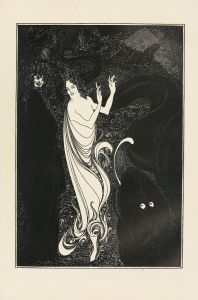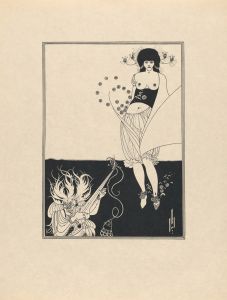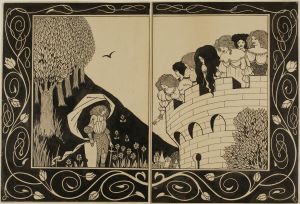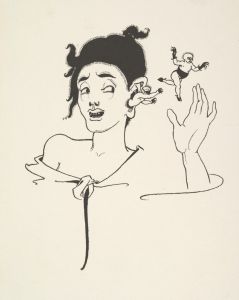
Illustration to Salome by Oscar Wilde 2
A hand-painted replica of Aubrey Vincent Beardsley’s masterpiece Illustration to Salome by Oscar Wilde 2, meticulously crafted by professional artists to capture the true essence of the original. Each piece is created with museum-quality canvas and rare mineral pigments, carefully painted by experienced artists with delicate brushstrokes and rich, layered colors to perfectly recreate the texture of the original artwork. Unlike machine-printed reproductions, this hand-painted version brings the painting to life, infused with the artist’s emotions and skill in every stroke. Whether for personal collection or home decoration, it instantly elevates the artistic atmosphere of any space.
Aubrey Vincent Beardsley was a prominent English illustrator and author known for his distinctive black and white illustrations. One of his most famous works is the series of illustrations created for Oscar Wilde's play "Salome," published in 1894. Among these, "Illustration to Salome by Oscar Wilde 2" stands out as a significant piece that showcases Beardsley's unique artistic style and the themes of the play.
Beardsley's illustrations for "Salome" were commissioned by John Lane of The Bodley Head, who was publishing the English edition of Wilde's play. The illustrations were completed in a style that combined elements of Art Nouveau with influences from Japanese woodcuts, which were popular in Europe at the time. Beardsley's work is characterized by its intricate line work, bold contrasts, and often provocative subject matter.
"Illustration to Salome by Oscar Wilde 2" is part of a series that visually interprets the narrative and themes of Wilde's play. "Salome" is a one-act play that tells the biblical story of Salome, the stepdaughter of Herod Antipas, who requests the head of John the Baptist as a reward for performing the Dance of the Seven Veils. The play explores themes of desire, power, and the macabre, which are vividly captured in Beardsley's illustrations.
In this particular illustration, Beardsley employs his signature style to depict the characters and scenes with a sense of drama and sensuality. The use of black and white creates a stark contrast that emphasizes the emotional intensity of the narrative. Beardsley's attention to detail and his ability to convey complex emotions through simple yet elegant lines are evident in this work.
The collaboration between Beardsley and Wilde was significant in the context of the Aesthetic Movement, which emphasized the importance of beauty and art for art's sake. Beardsley's illustrations were not mere accompaniments to the text but were integral to the overall experience of Wilde's play. They added a visual dimension that complemented Wilde's poetic and often controversial language.
Beardsley's work on "Salome" was met with both acclaim and criticism. Some praised his ability to capture the essence of Wilde's play, while others found his illustrations to be too provocative or decadent. Despite the mixed reception, Beardsley's illustrations for "Salome" have endured as iconic examples of late 19th-century art and continue to be studied for their artistic and cultural significance.
In summary, "Illustration to Salome by Oscar Wilde 2" by Aubrey Vincent Beardsley is a key piece in the series of illustrations for Wilde's play "Salome." It exemplifies Beardsley's unique artistic style and his ability to convey the complex themes of Wilde's work through visual art. The collaboration between Beardsley and Wilde remains an important moment in the history of art and literature, reflecting the spirit of the Aesthetic Movement and the cultural milieu of the late 19th century.














